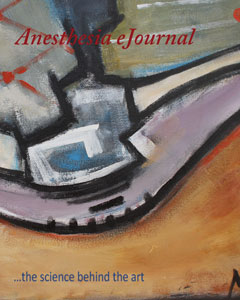Risk of Complications Using Laryngeal Mask Airway versus Endotracheal Tube During General Anesthesia in Pediatric Patients with Upper Respiratory Infections: A Narrative Review. Creation of the Upper Respiratory Infection Screening Tool© and Management Al
DOI:
https://doi.org/10.18776/tv28fx60Keywords:
pediatric, upper respiratory infection, anesthesia, laryngeal mask airway, endotracheal tubeAbstract
The inflammatory process that occurs in an upper respiratory
infection poses an increased risk of complications for children
undergoing general anesthesia for a surgical procedure. The anesthesia
providers need to decide which airway device, laryngeal
mask airways or endotracheal tubes, is most appropriate and has
less risk of adverse respiratory complications. A literature search
was completed using EMBASE, Cumulative Index to Nursing
and Allied Health Literature, and the Cochrane Library. Ten
articles were found comparing the use of laryngeal mask airways
and endotracheal tubes in children with upper respiratory infections.
Synthesis of the literature concluded that laryngeal mask
airways have a decreased risk of complications compared to
endotracheal tubes when used in children with recent or current
upper respiratory infections. With this information, the use of
a laryngeal mask airway should be considered in place of an
Volume 2, No. 1 13
endotracheal tube. The Upper Respiratory Infection Screening
Tool© and the Management Algorithm for Children Presenting
for General Anesthesia© were designed for quick recognition of
children at high risk for respiratory complications and provide
management techniques for anesthesia providers to follow.
References
Children’s Hospital Boston. Upper respiratory infection
(common cold). Children’s Hospital Boston website. http://
www.childrenshospital.org/az/Site1719/mainpageS1719P0.
html. Accessed February 25, 2012.
McGill WA, Coveler LA, Epstein BS. Subacute upper
respiratory infection in small children. Anesth Analg.
;58(4):331-333.
Tait AR, Malviya S. Anesthesia for the child with an upper
respiratory tract infection: still a dilemma? Anesth Analg.
;100(1):59-65.
Wakhloo R, Gupta SD, Gupta V, Ranbhushan. ETT
vs. LMA in pediatric patients with URI: a comparison
of adverse respiratory events. Internet J of Anesthesiol.
;14(2) http://find.galegroup.com.ezproxy.tcu.edu/
gtx/infomark.do?&content Set=IAC-Documents&type=r
etrieve&tabID=T002&prodId=AONE&docId=A177102
&source=gale&srcprod=AONE&userGroupName=txs
hracd2573&version=1.0. Accessed February 25, 2012.
von Ungern-Sternberg BS, Boda K, Schwab C, Sims C,
Johnson C, Habre W. Laryngeal mask airway is associated
with an increased incidence of adverse respiratory events
in children with recent upper respiratory tract infections.
Anesthesiol. 2007;107(5):714-719.
Tait AR, Pandit UA, Voepel-Lewis T, Munro HM, Malviya
S. Use of the laryngeal mask airway in children with upper
respiratory tract infections: a comparison with endotracheal
intubation. Anesth Analg. 1998;86(4):106-111.
Homer JR, Elwood T, Peterson D, Rampersad S. Risk
factors for adverse events in children with colds emerging
from anesthesia: a logistic regression. Pediatric Anesth.
;17(2):154-161.
Parnis SJ, Barker DS, Van Der Walt JH. Clinical predictors
of anaesthetic complications in children with respiratory
tract infections. Paediatric Anaesth. 2001;11(1):29-40.
AEJ
Eikermann M, Cote CJ. Laryngeal mask airway and children’s
risk of perioperative respiratory complications:
randomized controlled studies are required to discriminate
cause and effect [Editorial]. Anesth. 2008;108(6):1154.
Tartari S, Fratantonio R, Bomben R, Paolazzi M, Gritti G,
Alvisi R. Maschera laringea vs. tubo orotracheale in anestesia
pediatrica nella flogosi felle prime vie aeree [English
abstract]. Minerva Anestesiol. 2000;66(6):439-443.
Cohen MM, Cameron CB. Should you cancel the operation
when a child has an upper respiratory infection?
Anesth Analg. 1991;72(3):282-288.
Mosby’s Dictionary of Medicine, Nursing & Health
Professions. 7th ed. St. Louis, MO: Mosby Elsevier;
:648.
Pennant JH, White PF. The laryngeal mask airway. Anesth.
;79(1):144-163.
The Joanna Briggs Institute. Levels of evidence FAME.
The Joanna Briggs Institute website Available at: http://
www.joannabriggs.edu.au/Levels%20of%20Evidence%20
%20FAME. Updated February 19, 2012. Accessed March
, 2012.
Höhne C, Haack M, Machotta A, Kaisers U.
Atemwegsmanagement in der kinderanasthesie [English
translation]. Anaesthesist. 2006;55(7):809-820.
Flick RP, Wilder RT, Pieper SF, et al. Risk factors for laryngospasm
in children during general anesthesia. Pediatric
Anesth. 2008;18(4):289-296.
von Ungern-Sternberg BS, Johnson C, Habre W. Laryngeal
mask airway and children’s risk of perioperative respiratory
complications: randomized controlled studies
are required to discriminate cause and effect – in reply
[Editorial]. Anesthesiology. 2008:108(6):115
Downloads
Published
Issue
Section
License
Copyright (c) 2015 Megan Grelson, SRNA

This work is licensed under a Creative Commons Attribution-NonCommercial-ShareAlike 4.0 International License.
Authors agree to the Creative Commons License listed below, which can be viewed by clicking the link below.
This work will be licensed under a Creative Commons Attribution-NonCommercial-ShareAlike 4.0 International License.


